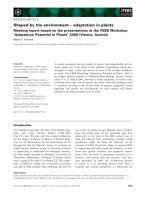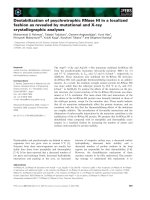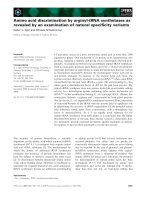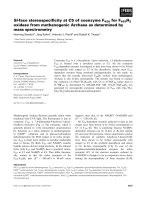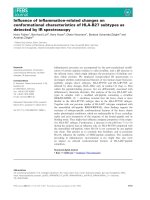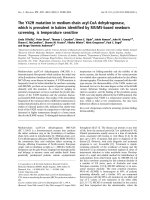Family environment as perceived by youth: Gender base
Bạn đang xem bản rút gọn của tài liệu. Xem và tải ngay bản đầy đủ của tài liệu tại đây (290.23 KB, 6 trang )
Int.J.Curr.Microbiol.App.Sci (2019) 8(4): 900-905
International Journal of Current Microbiology and Applied Sciences
ISSN: 2319-7706 Volume 8 Number 04 (2019)
Journal homepage:
Original Research Article
/>
Family Environment as Perceived by Youth: Gender Base
Pinki Ninaniya*, Santosh Sangwan and Shanti Balda
Department of Human Development and Family Studies, CCS Haryana Agriculture
University, Hisar, Haryana, India
*Corresponding author
ABSTRACT
Keywords
Adolescent, Family
Environment,
Behavior, Boys,
Girls
Article Info
Accepted:
10 March 2019
Available Online:
10 April 2019
The family is the basic unit of a society to attribute with biological functions. It is the
institution responsible for maintaining and building relationships among family members
as well as with the community. The present study has carried out in Hisar district of
Haryana state. For the study 200 adolescent i.e. 100 male and 100 female were taken
between the age group of 16-18 years. Family Environment Scale developed by Bhatia and
Chadha (1993) was used to assess home environment of the adolescent. Results of the
study revealed that significant differences were noted between cohesion, acceptance,
caring and control aspects of family environment. Results further revealed that girls had
more cohesion and control environment as compare to boys whereas boys received more
acceptance and caring from their family as compare to their counterparts.
perceptions of low cohesion within their
families were associated with heightened
feelings of depression and reduced social
acceptance (Wentzel and Feldman, 1996)
Thus, family members as members of a
primary group have extreme influence upon
each other. Adolescence is an important
developmental phase along the path to
adulthood, years during which youth become
increasingly independent from their families.
Parents and other family members still play a
critical role in the promotion of adolescents’
well-being, by providing a positive support
system within which youth can explore their
changing identity. Positive relationships with
parents, characterized by low conflict, high
Introduction
Family is an enduring association of parent
and off springs whose primary function are
the socialization of the child and satisfaction
of the members. Family plays an important
role during adolescence. It is a primary group
which requires “people who are intimate and
have frequent face-to face contact with one
another, have norms in common and share
mutually enduring and extensive influences.
Family cohesion (i.e., the emotional bonding
among family members and the feeling of
closeness) is expressed by feelings of
belonging and acceptance within the family
system (McKeown et al., 1997). Adolescent
900
Int.J.Curr.Microbiol.App.Sci (2019) 8(4): 900-905
levels
of
support,
and
open
communication, are especially important for
teens as they navigate the physical and
emotional changes of adolescence. Frequent
parent-adolescent
communication
and
positive identification with parents are
associated with less drug use, including less
drinking and smoking among teens. The
effectiveness of family functioning in
conditioning the children’s personality and
social development has an outstanding
importance (Roelfse and Middleton, 1985).
Similarly, adolescents who report that they
have a good relationship with at least one
parent are more likely to report good physical
and mental health. Family arguments during
adolescence are to be expected, and may even
serve
an
important
developmental
purpose. However, teens that experience high
levels of conflict with and/or low levels of
support from their parents are more likely to
engage in risk behaviours. Due to the rapid
changes within the modern family, the home
stills the most important factor in shaping the
behaviour of youth. The family climate is
significant as it has a far reaching effect on its
every member through various experiences
and conditions of the family. A healthy home
atmosphere and the factors that produce it are
very important influences on adolescent’s
outlook for life. Better the communication
between parents and children and greater the
marital consensus and better the behaviour
outcomes for adolescent children (Farell and
Barnes, 1993). Adolescents need love and
support from parents at a time when lots of
other things in their lives are changing.
During this time family is still a secure
emotional base where the child feels loved
and accepted, no matter what’s going on in
the rest of his life. Family can build and
support the child’s confidence, self-belief,
optimism and identity. Role of the family
context in adolescent well-being goes beyond
the importance of the direct relationship
between a parent and a child. Effective family
functioning
defined
by
cohesion,
expressiveness and high personal growth are
related positively to peer relations and role
compliance. The more cohesive a family, the
better the individual family members to
function, the better the communication
between parents and children and greater the
marital consensus and better the behaviour
outcomes for adolescent children (Farell&
Barnes, 1993).
Materials and Methods
Locale of the Study
Hisar district of Haryana state was
purposively selected to get the sample for
present study.
Selection of area
A list of villages having Senior Secondary
Schools was procured from the Education
Department of Hisar District. From the list
two villages i.e. Arya Nagar from block Hisar
I and Dabra from block Hisar II were selected
randomly. Further two government schools,
one each from selected villages were taken
randomly to draw the rural sample and similar
procedure was followed for urban sample.
Two schools, namely Campus Senior
Secondary School and Thakur Das Bhargava
Senior Secondary School, Hisar were selected
randomly for urban sample.
Sampling procedure
The study was confined to young adolescents
of class 11th and 12th in the age group 16-18
years from selected all four schools. From
each school, 50 adolescents equally
representing both the sex i.e. 25 girls and 25
boys were selected on random basis. Hence, a
total of 200 adolescents constituted the
sample for present investigation.
901
Int.J.Curr.Microbiol.App.Sci (2019) 8(4): 900-905
(64.5%), organization (66%) and control
(66.5%).
Instrument
Family Environment Scale developed by
Bhatia and Chadha (1993) was used to assess
home environment of the adolescents and its
eight aspects i.e. Cohesion, Expressiveness,
Conflict, Acceptance and Caring, Activerecreational
orientation,
Independence,
Organization, Control. This includes both
positives as well as negatives items and
scored as extremely agree, agree, undecided,
disagree, strongly disagree. The maximum
score for positive item is awarded is 5 and
least is 1. In case of negative items the
scoring procedure is to be reversed.
Turning towards the gender wise comparison
it showed that boys had better quality of
family environment as results showing higher
percentages on different aspects of family
environment like expressiveness (19%),
conflict (15%), and acceptance and caring
(21%), active recreational orientation (19%)
and independence (22%) than their
counterparts. Whereas, girls scored high on
organization (19%) and control (20%) aspects
of family environment as compare to boys as
they were found less organized and had less
control of family on them.
Data Collection
Mean comparison of respondents for
quality of family environment as per
gender
The data was collected personally on
individual basis with the help of standardized
tool. The class teachers of the selected class
from different schools were given prior
information for the data and time of visit.
Comparison emanated from quality of family
environment as per gender is displayed in
table 2. Results showed that there were
significant differences exist between cohesion
(Z=1.99*) and acceptance and caring
(Z=2.08*) aspects of family environment and
gender. Moving towards comparison of mean
scores of girl and boys, draw attention that
girls had more cohesion (M=53.30) and
control environment (M=15.04) as compare to
boys as they had less cohesion (M= 50.34)
and control environment (M=14.81) in their
family. Turning towards acceptance and
caring aspects of family environment, boys
received more acceptance and caring
(M=45.35) from their family as compare to
their counterparts (M=42.95).
Statistical analysis
Frequency distribution and percentages were
used to interpret the data. Z-test test was used
for calculating the differences between means
of independent variables of two large
samples.
Results and Discussion
Gender wise perception of adolescents for
family environment
Data in table 1 exhibits the distribution of
respondents for quality of family environment
as per gender. Perusal of results revealed that
out of total sample more than fifty percent of
adolescents fall in average category of family
environment
in
cohesion
(65%),
expressiveness (67.5%), conflict (60.5%),
acceptance and caring (67%) active
recreational orientation (66.5%) independence
The child constantly interacts with the family
and is invariably influenced by the entire
environment that surrounds him. Each child
needs a congenial atmosphere, as he is
innocent, tender and delicate since birth and
needs someone who can nourish them with
love and care.
902
Int.J.Curr.Microbiol.App.Sci (2019) 8(4): 900-905
The gender wise comparison showed that
boys had better quality of family environment
as results showing higher percentages on
different aspects of family environment like
expressiveness, conflict, acceptance and caring,
active recreational orientation and independence
whereas, girls scored high on organization and
control aspects of family environment. Boys
were found less organized and had less
control
of
family
on
them.
Table.1 Perception of adolescents for their family environment
Sr.
no.
1
2
3
4
5
6
7
8
Aspects of family
environment
Boys
n = 100
Cohesion
Low (45and below)
17 (17.0)
Average (46to 60)
69 (69.0)
High (61and above)
14 (14.0)
Expressiveness
Low (27and below)
11 (11.0)
Average (28 to 39)
70 (70.0)
High (40 and above)
19 (19.0)
Conflict
Low (37 and below)
18 (18.0)
Average (38 to 51)
67 (67.0)
High (52 and above)
15 (15.0)
Acceptance and caring
Low (40 and below)
09(9.0)
Average (41 to 56)
70(70.0)
High (57 and above)
21(21.0)
Active-recreational orientation
Low (30 and below)
10 (10.0)
Average (31 to 40)
71 (71.0)
High (41 and above)
19 (19.0)
Independence
Low (6 and below)
09 (09.0)
Average (7 to 9)
69 (69.0)
High (10 and above)
22 (22.0)
Organization
Low (6 and below)
26 (26.0)
Average (7 to 9)
62 (62.0)
High (10 and above)
12 (12.0)
Control
Low (13 and below)
23(23.0)
Average (14 to 17)
64(64.0)
High (18 and above)
13(13.0)
Note: Figures in parentheses indicate percentages
903
Girls
n = 100
Total
N=200
23 (10.0)
61 (43.0)
16 (57.0)
40 (20.0)
130 (65.0)
30 (15.0)
20 (13.0)
65 (18.0)
15 (15.0)
31 (15.5)
135 (67.5)
34 (17.0)
22 (18.0)
64 (60.0)
14 (22.0)
40 (20.0)
131 (65.5)
29 (14.5)
23 (08.0)
64 (37.0)
13 (55.0)
32 (16.0)
134 (67.0)
34 (17.0)
15 (15.0)
68 (68.0)
17 (17.0)
27 (13.5)
139 (66.5)
34 (17.0)
27 (27.0)
60 (60.0)
13 (13.0)
36 (18.0)
129 (64.5)
35 (17.5)
11 (11.0)
70 (70.0)
19 (19.0)
37 (18.5)
132 (66.0)
31 (15.5)
11(11.0)
69(69.0)
20(20.0)
34 (16.5)
133 (66.5)
33 (14.0)
Int.J.Curr.Microbiol.App.Sci (2019) 8(4): 900-905
Table.2 Comparison of respondents for quality of family environment on the basis of gender
Sr.no.
1
2
3
4
5
6
7
8
Aspects
of
family
environment
Cohesion
Expressiveness
Conflict
Acceptance and caring
Active
recreational
orientation
Independence
Organization
Control
Boys
Mean ± SD
50.34±8.17
32.18±6.19
40.63±6.77
45.35±5.69
28.03±4.59
Girls
Mean ± SD
53.30±6.39
32.19±4.07
40.65±6.23
42.95±6.41
28.57±5.88
‘Z’ value
30.68±4.63
8.36±2.49
14.81±3.31
31.76±4.38
8.29±1.61
15.04±2.44
1.12
0.61
0.50
1.99*
0.22
0.11
2.08*
1.49
*Significant at 5% level of significance
Comparison emanated from quality of family
environment and gender results showed that
there were significant differences exist
between cohesion and acceptance and caring
aspects of family environment and gender.
These findings are similar to previous
findings of Mohanraj and Latha (2005) boys
perceived more control i.e., they perceived
that their family has set rules and emphasize
on following rules in the family.
References
Bhatia, H. and Chadha, N.K. 1993. Family
environment scale (FES). Ankur
Psychological Agency, 22/481, Indra
Nagar, Lucknow.
Farell, M.P., and Branes, G.M. 1993 Family
system and social support. A test of the
effects of cohesion and adaptability on
functioning of parents and adolescents.
Journal of Marriage & Family, 55,119132.
McKeown, R. E., Garrison, C. Z., Jackson, K.
L., Cuffe, S. P., Addy, C. L., and
Waller, J. L. (1997).Family structure
and cohesion, and depressive symptoms
in adolescents. Journal of Research on
Adolescence, 7, 267-282.
Mohanraj, R. Latha, 2005. Perceived family
environment in relationto adjustment
and academic achievement. Journal of
the Indian Academic of Applied
Psychological, 31:18-23.
Roelfse, R. and Middleton, M. R. (1985).: A
measure of psychosocial family health
during
adolescence.
Journal
of
Adolescence, 8, 33-45.
Verma, R.K. and Ghadialy, R. 1985. Effect of
mother’s sex role attitude on needs for
achievements and expectancy for
The boys are more sensitized than girls by
control in the family. The result of Verma and
Ghadially, (1985) supported with the earlier
finding also that male children receive more
independence and encouragement than
females because of cultural roles assigned to
both the sexes in adult life.
In conclusion, the result revealed that boys
had better quality of family environment on
different aspects like expressiveness, conflict,
acceptance and caring, active recreational
orientation and independence than their
counterparts.
Whereas, girls scored high on organization
and control aspects of family environment as
compare to boys as they were found less
organized and had less control of family on
them.
904
Int.J.Curr.Microbiol.App.Sci (2019) 8(4): 900-905
success in children. Psychological
Studies, 30 (1):1-4.
Wentzel, K. R., and Feldman, S. S. (1996).
Relations of cohesion and power in
family dyads to social and emotional
adjustment during early adolescence.
Journal of Research on Adolescences,
2,225-245.
How to cite this article:
Pinki Ninaniya, Santosh Sangwan and Shanti Balda. 2019. Family Environment as Perceived
by Youth: Gender Base. Int.J.Curr.Microbiol.App.Sci. 8(04): 900-905.
doi: />
905

